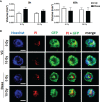Stromal Fibroblasts Counteract the Caveolin-1-Dependent Radiation Response of LNCaP Prostate Carcinoma Cells
- PMID: 35155239
- PMCID: PMC8826751
- DOI: 10.3389/fonc.2022.802482
Stromal Fibroblasts Counteract the Caveolin-1-Dependent Radiation Response of LNCaP Prostate Carcinoma Cells
Abstract
In prostate cancer (PCa), a characteristic stromal-epithelial redistribution of the membrane protein caveolin 1 (CAV1) occurs upon tumor progression, where a gain of CAV1 in the malignant epithelial cells is accompanied by a loss of CAV1 in the tumor stroma, both facts that were correlated with higher Gleason scores, poor prognosis, and pronounced resistance to therapy particularly to radiotherapy (RT). However, it needs to be clarified whether inhibiting the CAV1 gain in the malignant prostate epithelium or limiting the loss of stromal CAV1 would be the better choice for improving PCa therapy, particularly for improving the response to RT; or whether ideally both processes need to be targeted. Concerning the first assumption, we investigated the RT response of LNCaP PCa cells following overexpression of different CAV1 mutants. While CAV1 overexpression generally caused an increased epithelial-to-mesenchymal phenotype in respective LNCaP cells, effects that were accompanied by increasing levels of the 5'-AMP-activated protein kinase (AMPK), a master regulator of cellular homeostasis, only wildtype CAV1 was able to increase the three-dimensional growth of LNCaP spheroids, particularly following RT. Both effects could be limited by an additional treatment with the SRC inhibitor dasatinib, finally resulting in radiosensitization. Using co-cultured (CAV1-expressing) fibroblasts as an approximation to the in vivo situation of early PCa it could be revealed that RT itself caused an activated, more tumor-promoting phenotype of stromal fibroblats with an increased an increased metabolic potential, that could not be limited by combined dasatinib treatment. Thus, targeting fibroblasts and/or limiting fibroblast activation, potentially by limiting the loss of stromal CAV1 seems to be absolute for inhibiting the resistance-promoting CAV1-dependent signals of the tumor stroma.
Keywords: SRC; caveolin-1; dasatinib; fibroblast; prostate cancer; radiotherapy; therapy resistance; tumor microenvironment.
Copyright © 2022 Wittka, Ketteler, Borgards, Maier, Herskind, Jendrossek and Klein.
Conflict of interest statement
The authors declare that the research was conducted in the absence of any commercial or financial relationships that could be construed as a potential conflict of interest.
Figures








Similar articles
-
Progression-Related Loss of Stromal Caveolin 1 Levels Mediates Radiation Resistance in Prostate Carcinoma via the Apoptosis Inhibitor TRIAP1.J Clin Med. 2019 Mar 12;8(3):348. doi: 10.3390/jcm8030348. J Clin Med. 2019. PMID: 30871022 Free PMC article.
-
Caveolin-1 regulates the ASMase/ceramide-mediated radiation response of endothelial cells in the context of tumor-stroma interactions.Cell Death Dis. 2020 Apr 9;11(4):228. doi: 10.1038/s41419-020-2418-z. Cell Death Dis. 2020. PMID: 32273493 Free PMC article.
-
Progression-related loss of stromal Caveolin 1 levels fosters the growth of human PC3 xenografts and mediates radiation resistance.Sci Rep. 2017 Jan 23;7:41138. doi: 10.1038/srep41138. Sci Rep. 2017. PMID: 28112237 Free PMC article.
-
Caveolin-1, cancer and therapy resistance.Int J Cancer. 2018 Nov 1;143(9):2092-2104. doi: 10.1002/ijc.31369. Epub 2018 Mar 30. Int J Cancer. 2018. PMID: 29524224 Review.
-
Tyrosine phosphorylation of tumor cell caveolin-1: impact on cancer progression.Cancer Metastasis Rev. 2020 Jun;39(2):455-469. doi: 10.1007/s10555-020-09892-9. Cancer Metastasis Rev. 2020. PMID: 32440845 Review.
Cited by
-
Non-small cell lung cancer cells and concomitant cancer therapy induce a resistance-promoting phenotype of tumor-associated mesenchymal stem cells.Front Oncol. 2024 Jul 1;14:1406268. doi: 10.3389/fonc.2024.1406268. eCollection 2024. Front Oncol. 2024. PMID: 39011489 Free PMC article.
-
Medium- and long-chain triglyceride propofol activates PI3K/AKT pathway and inhibits non-alcoholic fatty liver disease by inhibiting lipid accumulation.J Bioenerg Biomembr. 2024 Feb;56(1):45-53. doi: 10.1007/s10863-023-09997-0. Epub 2023 Nov 30. J Bioenerg Biomembr. 2024. PMID: 38032443
-
Complex Spheroids as an Alternative: In Vivo-Like 3D Model for Investigating the Impact of Stromal Cells on the Radiation Response of Tumors.Methods Mol Biol. 2025;2951:257-266. doi: 10.1007/7651_2025_614. Methods Mol Biol. 2025. PMID: 40172832
-
Proteomics of High-Grade Serous Ovarian Cancer Models Identifies Cancer-Associated Fibroblast Markers Associated with Clinical Outcomes.Biomolecules. 2022 Dec 30;13(1):75. doi: 10.3390/biom13010075. Biomolecules. 2022. PMID: 36671461 Free PMC article.
References
LinkOut - more resources
Full Text Sources
Miscellaneous

